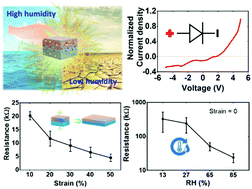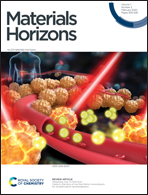An ambient-stable and stretchable ionic skin with multimodal sensation†
Abstract
Skin serves as a physical and hygroscopic barrier to protect the inner body, and also contains sensory receptors to perceive environmental and mechanical stimuli. To recapitulate these salient features, hydrogel-based artificial skins have been developed. However, existing designs are constrained by limited functionality, low stability, and requirement of external power. Herein, a novel artificial ionic skin (AIskin) – an analog of the diode based on controlled ion mobility – is demonstrated with high toughness, stretchability, ambient stability and transparency. The AIskin consists of a bilayer of oppositely-charged, double-network hydrogel, and converts mechanical stimuli and humidity into signals of resistance, capacitance, open-circuit voltage (OCV), and short-circuit current (SCC), among which the OCV- and SCC-based sensing signals are self-generated. Its multimodal sensation is maintained in a wide range of relative humidities (13–85%). It is demonstrated for wearable strain-humidity sensing, human–machine interaction and walking energy harvesting. This work will open new avenues toward next-generation, skin-inspired wearable electronics.

- This article is part of the themed collections: Materials Horizons Emerging Investigators Series 2020/2021, 2020 Horizons Outstanding Paper Award Winners and 2020 Materials Horizons most popular articles


 Please wait while we load your content...
Please wait while we load your content...